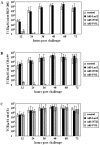Adenovirus-mediated RNA interference against foot-and-mouth disease virus infection both in vitro and in vivo
- PMID: 16537624
- PMCID: PMC1440392
- DOI: 10.1128/JVI.80.7.3559-3566.2006
Adenovirus-mediated RNA interference against foot-and-mouth disease virus infection both in vitro and in vivo
Abstract
Foot-and-mouth disease virus (FMDV) infection is responsible for the heavy economic losses in stockbreeding each year. Because of the limited effectiveness of existing vaccines and antiviral drugs, the development of new strategies is needed. RNA interference (RNAi) is an effective means of suppressing virus replication in vitro. Here we demonstrate that treatment with recombinant, replication-defective human adenovirus type 5 (Ad5) expressing short-hairpin RNAs (shRNAs) directed against either structural protein 1D (Ad5-NT21) or polymerase 3D (Ad5-POL) of FMDV totally protects swine IBRS-2 cells from homologous FMDV infection, whereas only Ad5-POL inhibits heterologous FMDV replication. Moreover, delivery of these shRNAs significantly reduces the susceptibility of guinea pigs and swine to FMDV infection. Three of five guinea pigs inoculated with 10(6) PFU of Ad5-POL and challenged 24 h later with 50 50% infectious doses (ID50) of homologous virus were protected from the major clinical manifestation of disease: the appearance of vesicles on the feet. Two of three swine inoculated with an Ad5-NT21-Ad5-POL mixture containing 2 x 10(9) PFU each and challenged 24 h later with 100 ID50 of homologous virus were protected from the major clinical disease, but treatment with a higher dose of adenovirus mixture cannot promote protection of animals. The inhibition was rapid and specific because treatment with a control adenovirus construct (Ad5-LacZ) expressing Escherichia coli galactosidase-specific shRNA showed no marked antiviral activity. Our data highlight the in vivo potential of RNAi technology in the case of FMD.
Figures





Similar articles
-
Rapid protection of cattle from direct challenge with foot-and-mouth disease virus (FMDV) by a single inoculation with an adenovirus-vectored FMDV subunit vaccine.Virology. 2005 Jul 5;337(2):205-9. doi: 10.1016/j.virol.2005.04.014. Virology. 2005. PMID: 15893355
-
Induction of protective immunity in swine by immunization with live attenuated recombinant pseudorabies virus expressing the capsid precursor encoding regions of foot-and-mouth disease virus.Vaccine. 2008 May 23;26(22):2714-22. doi: 10.1016/j.vaccine.2008.03.020. Epub 2008 Apr 1. Vaccine. 2008. PMID: 18436351
-
Cross-inhibition to heterologous foot-and-mouth disease virus infection induced by RNA interference targeting the conserved regions of viral genome.Virology. 2005 May 25;336(1):51-9. doi: 10.1016/j.virol.2005.01.051. Virology. 2005. PMID: 15866070
-
Innate immune responses against foot-and-mouth disease virus: current understanding and future directions.Vet Immunol Immunopathol. 2009 Mar 15;128(1-3):205-10. doi: 10.1016/j.vetimm.2008.10.296. Epub 2008 Oct 17. Vet Immunol Immunopathol. 2009. PMID: 19026453 Review.
-
Recombinant DNA technology for the preparation of subunit vaccines.J Am Vet Med Assoc. 1982 Nov 15;181(10):992-9. J Am Vet Med Assoc. 1982. PMID: 6129235 Review.
Cited by
-
Transgenic shRNA pigs reduce susceptibility to foot and mouth disease virus infection.Elife. 2015 Jun 19;4:e06951. doi: 10.7554/eLife.06951. Elife. 2015. PMID: 26090904 Free PMC article.
-
Silencing of African horse sickness virus VP7 protein expression in cultured cells by RNA interference.Virus Genes. 2007 Dec;35(3):777-83. doi: 10.1007/s11262-007-0162-4. Epub 2007 Sep 13. Virus Genes. 2007. PMID: 17851744
-
RNAi-based inhibition of porcine reproductive and respiratory syndrome virus replication in transgenic pigs.J Biotechnol. 2014 Feb 10;171:17-24. doi: 10.1016/j.jbiotec.2013.11.022. Epub 2013 Dec 11. J Biotechnol. 2014. PMID: 24333125 Free PMC article.
-
Evaluation of a combinatorial RNAi lentivirus vector targeting foot-and-mouth disease virus in vitro and in vivo.Mol Med Rep. 2015 Nov;12(5):6672-8. doi: 10.3892/mmr.2015.4246. Epub 2015 Aug 25. Mol Med Rep. 2015. PMID: 26323462 Free PMC article.
-
RNA interference targeting virion core protein ORF095 inhibits Goatpox virus replication in Vero cells.Virol J. 2012 Feb 17;9:48. doi: 10.1186/1743-422X-9-48. Virol J. 2012. PMID: 22340205 Free PMC article.
References
-
- Bachrach, H. L. 1968. Foot-and-mouth disease virus. Annul. Rev. Microbiol. 22:201-244. - PubMed
-
- Barnett, P. V., and H. Carabin. 2002. A review of emergency foot-and-mouth disease (FMD) vaccines. Vaccine 20:1505-1514. - PubMed
-
- Barteling, S. J., and J. Vreeswijk. 1991. Developments in foot-and-mouth disease vaccines. Vaccine 9:75-88. - PubMed
-
- Bayry, J., and D. F. Tough. 2005. Is RNA interference feasible for the control of foot-and-mouth disease outbreaks? Trends Immunol. 26:238-239. - PubMed
-
- Chen, W., M. Liu, G. Cheng, W. Yan, L. Fei, and Z. Zheng. 2005. RNA silencing: a remarkable parallel to protein-based immune systems in vertebrates? FEBS Lett. 579:2267-2272. - PubMed
Publication types
MeSH terms
Substances
LinkOut - more resources
Full Text Sources
Other Literature Sources

